Categories
- Argentina
- Chile
- Antarctica
- Easter Island
- Falklands (Malvinas)
- Bolivia
- Peru
- Uruguay
- Paraguay
- Brazil
- Venezuela
- Colombia
- Ecuador
- Galapagos
- Panama
- Costa Rica
- Cuba
- Nicaragua
- Honduras
- El Salvador
- Guatemala
- Belize
- Mexico
- Latin American Xmas
Pages
- Map of South America
- Home Page
- First week in Latin America – October 2009
- Map of Central America
- Contact Us
- The Jesuit Missions in South America
- A week in Buenos Aires
- Street Art of Buenos Aires
Archives
- October 2011 (3)
- September 2011 (9)
- August 2011 (10)
- July 2011 (7)
- June 2011 (6)
- May 2011 (11)
- April 2011 (10)
- March 2011 (4)
- February 2011 (5)
- January 2011 (6)
- December 2010 (6)
- November 2010 (4)
- October 2010 (8)
- September 2010 (5)
- August 2010 (7)
- July 2010 (5)
- June 2010 (6)
- May 2010 (6)
- April 2010 (7)
- March 2010 (6)
- February 2010 (9)
- January 2010 (4)
- December 2009 (8)
- November 2009 (5)
- October 2009 (2)
Lake Nicaragua
28th April 2011
What were we thinking, crossing from Costa Rica to Nicaragua at Easter? The line of trucks was 20 kilometres and 4 days long. We joined the hoards of people at the border and eventually made it to San Jorge [1], near Rivas on Lake Nicaragua. Holiday celebrations were in full swing on the beach.
.
The next day we joined more hoards of happy local holiday makers on the one hour ferry across the lake to Ometepe Island, rising out of the lake with its two perfectly formed volcanic peaks over 1600 meters high joined by an isthmus of lava. Once on the island the crowds soon dispersed and Moyogalpa, the capital, went back to being a pueblo tranquilo – a sleepy little village. Ancient civilizations, believed to have come from Mexico and Central America, held the island sacred and left behind stone statues and petroglyphs depicting birds, animals, humans as well as geometric shapes. Shards of pottery from pots thrown into the lake by indigenous people as the Spanish approached can still be found washed up on the black sand beaches.
.
The delightful colonial city of Granada [2] sits on the western edge of the lake. Nicaragua´s oldest city was founded in 1524, almost completely destroyed in 1856 by fire but later restored to the gem it is today. The heat kept us indoors during the day but in the evenings it was pleasant strolling and sampling freshly made tortillas, roast corn and grilled meat sold by vendors along the cobbled streets.
.
Rock from an eruption of the nearby Mombacho Volcano thousands of years ago, formed some 350 islets near the city. We spent a pleasant morning on a boat ride between the islets inhabited by traditional fishing families and Nicaragua’s´ rich and famous. One islet is home to some spider monkeys that jumped onto our boat.
.
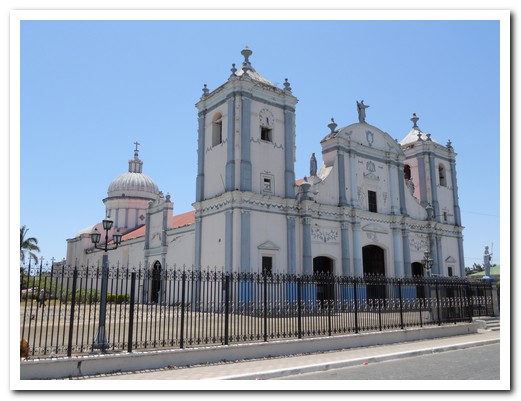
Rivas Cathedral
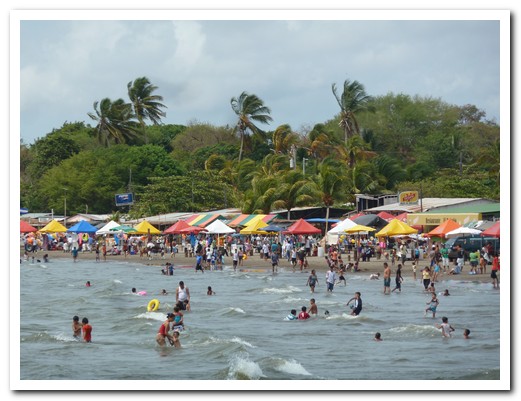
Locals celebrate Easter on Lake Nicaragua

Twin volcanoes of Isla Ometepe

Moyogalpa Church on the island

Easter procession

Volcán Concepción towers over Moyogalpa

Volcán Maderas

Last ferry of the day

Shady road to a beach

Bright blue Urraca

Orchid

Orchid

Pre-Colombian stone statue

Pre-Colombian stone statue

Petroglyph over 2000 years old depicting a calendar
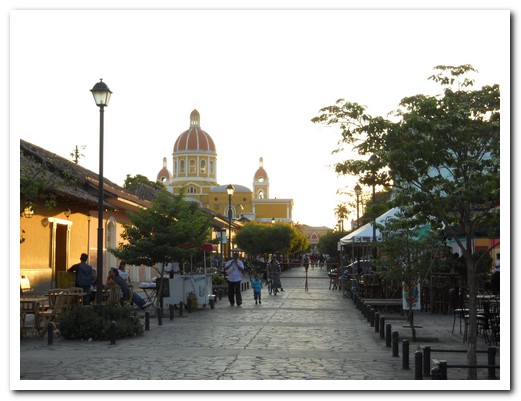
Evening in Granada

Iglesia Guadalupe

Iglesia La Merced

Meat grilling on the side walk makes a tasty $2 meal
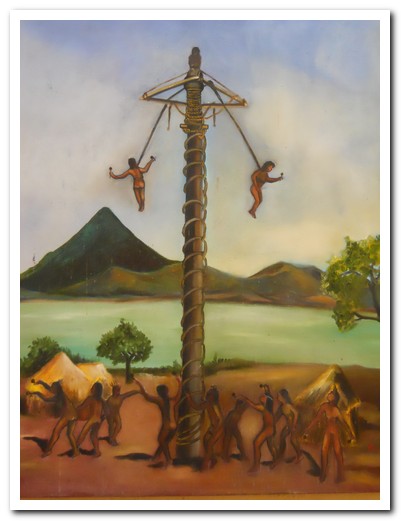
Painting of pre-Hispanic pole dance

Early pot

Mombacho Volcano near Granada

One of the 350 islets formed by the explosion of Mombacho

A spider monkey joins us on the boat

Tiger heron

Pretty water birds around the islets

White heron

Cashew nuts on the tree
León – City of Churches
01st May 2011
The colonial city of León [3] was originally founded in 1524 but was moved to its present site in the 17th century after an earthquake destroyed the old city. It is a city of churches, mostly built in the neoclassical style. Some have the supporting columns and ceilings made from centuries old hand hewn timber. The cathedral, the largest in Central America takes up an entire city block.
.
The area around León is the most volcanic in Central America, with 10 active nearby. One of the activities is sliding down a volcano at 70 kph on a snow board – gave that a miss.
.

Village church built by indigenous, near León

Village church built by indigenous, near León

Village church built by indigenous, near León

León Cathedral, the largest in Central America

One of the bells on the Cathedral
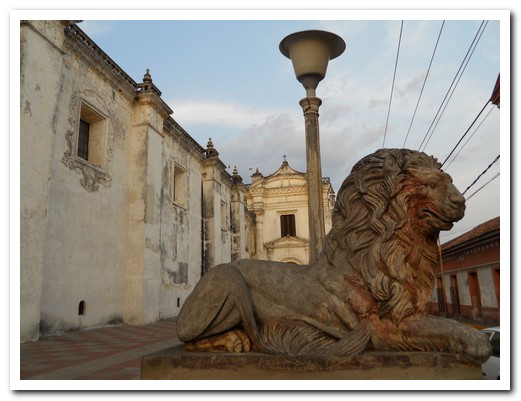
Leones (lions) guard the Cathedral

Collegio de San Ramon

Iglesia la Reccoleción

Iglesia el Calvario

Decorative wooden ceiling in the Iglesia el Calvario

Iglesia San Juan

Inside San Juan

Iglesia San Felipe

Angel stands outside san Felipe

Iglesia Zaragoza

Iglesia Laborio

Iglesia La Merced

Side door in Mudéjar style of La Merced

Corner doors are common in León

León street

Lady sells fruit along the street

A smoking volcano just ouside León
Northern Highlands of Nicaragua
04th May 2011
We are heading north towards Honduras in bum numbing local chicken buses (retired US school buses). Three big Nicas squeeze in where once a couple of kids sat. Nicaragua´s countryside is parched, waiting for the wet season. The northern highlands where coffee, cattle and tobacco are grown is a little cooler and a relief from the oppressive humidity of the coast. Matagalpa [4], the coffee capital, sits in a small valley and sprawls up the surrounding hills. It has a blinding white cathedral from the 19th century.
.
Our school bus laboured uphill through cloud forest, winding past coffee farms, taking an hour and a half to travel the 34 kilometres to sleepy Jinotega, 1100 meters [5]. At the market delicious looking and smelling fresh fruit and vegetables were being sold from stalls lining the roads. Men in cowboy hats saunter around town.
.
After a 3 hour bus from Jinotega to Estelí [6] we had had enough for one day. There was not much to do in Estelí, but there were no tourists either. Maybe this is the “real” Nicaragua.
.
Our last stop before Honduras was Ocotal [7], founded by Spanish colonialists in 1543.
.

Matagalpa Cathedral

The Jasper County Community Unit 1 school bus still has years of service in northern Nicaragua

Jinotega Cathedral

Jinotega market

Cowboy on the bus

You´ll need one of these hats ...

... if you don´t have one, get it here

Cowboy comes to town

Live chickens for sale at the bus stop

Estelí, a big country town

The countryside is brown and dry, soon the rains will come

Typical breakfast with gallo pinto - rice and red beans

The 200 year old church in Ocotal has an old tower and a newer one